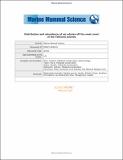Files in this item
Distribution and abundance of sei whales off the west coast of the Falkland Islands
Item metadata
| dc.contributor.author | Weir, Caroline R. | |
| dc.contributor.author | Taylor, Maria | |
| dc.contributor.author | Jelbes, Pamela A. Q. | |
| dc.contributor.author | Stanworth, Andrew | |
| dc.contributor.author | Hammond, Philip S. | |
| dc.date.accessioned | 2022-02-13T00:39:28Z | |
| dc.date.available | 2022-02-13T00:39:28Z | |
| dc.date.issued | 2021-07 | |
| dc.identifier | 272949574 | |
| dc.identifier | 288f467d-64b8-4e69-bbe6-a898c3a1ec49 | |
| dc.identifier | 85100854770 | |
| dc.identifier | 000617552400001 | |
| dc.identifier.citation | Weir , C R , Taylor , M , Jelbes , P A Q , Stanworth , A & Hammond , P S 2021 , ' Distribution and abundance of sei whales off the west coast of the Falkland Islands ' , Marine Mammal Science , vol. 37 , no. 3 , pp. 919-933 . https://doi.org/10.1111/mms.12784 | en |
| dc.identifier.issn | 0824-0469 | |
| dc.identifier.other | RIS: urn:0EAF94ABA558BCCF08161EA546DA3846 | |
| dc.identifier.other | ORCID: /0000-0002-2381-8302/work/89178157 | |
| dc.identifier.uri | https://hdl.handle.net/10023/24861 | |
| dc.description | The survey was funded by Falklands Conservation, the Royal Society for the Protection of Birds, and the Falkland Islands Government Environmental Studies Budget. | en |
| dc.description.abstract | Little information exists on the current status of Southern Hemisphere sei whales (Balaenoptera borealis). We assessed their distribution and abundance along the west coast of the Falkland Islands (southwest Atlantic) during February and March 2018, using line transect and nonsystematic surveys. Abundance estimates were generated for a single survey stratum using design- and model-based approaches. Sightings of sei whales and unidentified baleen whales (most, if not all, likely to be sei whales) occurred from the coast to the 100 m depth isobath that marked the offshore boundary of the stratum. The modeled distribution predicted highest whale densities in King George Bay and in the waters between Weddell Island and the Passage Islands. Sei whale abundance was estimated as 716 animals (CV = 0.22; 95% CI [448, 1,144]; density = 0.20 whales/km2) using the design-based approach, and 707 animals (CV = 0.11; 95% CI [566, 877]; density = 0.20 whales/km2) using the model-based approach. For sei whales and unidentified baleen whales combined, the equivalent estimates were 916 animals (CV = 0.19; 95% CI [606, 1,384]; density = 0.26 whales/km2) and 895 animals (CV = 0.074; 95% CI [777, 1,032]; density = 0.25 whales/km2). The data indicate that the Falkland Islands inner shelf region may support globally important seasonal feeding aggregations of sei whales, and potentially qualify as a Key Biodiversity Area. | |
| dc.format.extent | 15 | |
| dc.format.extent | 3673837 | |
| dc.language.iso | eng | |
| dc.relation.ispartof | Marine Mammal Science | en |
| dc.subject | Atlantic Ocean | en |
| dc.subject | Balaenoptera borealis | en |
| dc.subject | Coastal | en |
| dc.subject | Density | en |
| dc.subject | Feeding ground | en |
| dc.subject | Key Biodiversity Area | en |
| dc.subject | Management | en |
| dc.subject | Southern Hemisphere | en |
| dc.subject | GC Oceanography | en |
| dc.subject | QL Zoology | en |
| dc.subject | NDAS | en |
| dc.subject | AC | en |
| dc.subject.lcc | GC | en |
| dc.subject.lcc | QL | en |
| dc.title | Distribution and abundance of sei whales off the west coast of the Falkland Islands | en |
| dc.type | Journal article | en |
| dc.contributor.institution | University of St Andrews. School of Biology | en |
| dc.contributor.institution | University of St Andrews. Sea Mammal Research Unit | en |
| dc.contributor.institution | University of St Andrews. Scottish Oceans Institute | en |
| dc.contributor.institution | University of St Andrews. Centre for Research into Ecological & Environmental Modelling | en |
| dc.contributor.institution | University of St Andrews. Marine Alliance for Science & Technology Scotland | en |
| dc.identifier.doi | https://doi.org/10.1111/mms.12784 | |
| dc.description.status | Peer reviewed | en |
| dc.date.embargoedUntil | 2022-02-13 |
This item appears in the following Collection(s)
Items in the St Andrews Research Repository are protected by copyright, with all rights reserved, unless otherwise indicated.

